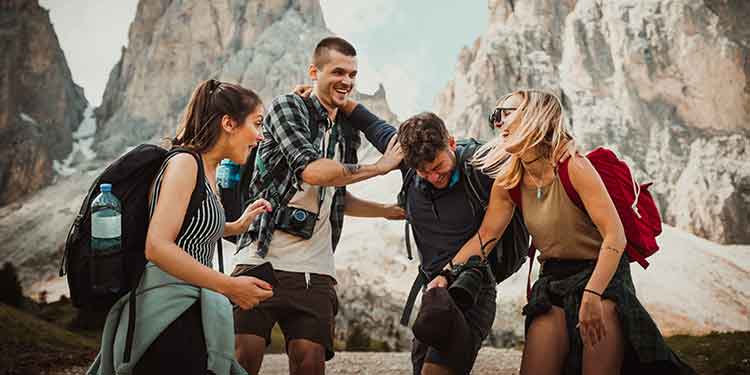Disclosure: I am compensated for purchases made through some links on this site. Click for details.
Isn’t hiking amazing?! Immersing yourself in nature through hiking is a great way to increase your physical and mental well-being.1,2 But it can take a toll on your body, especially your knees.
To protect your knees while hiking, wear knee braces for stability and protection, use trekking poles to improve stability and reduce strain and impact, wear hiking boots to improve stability and traction while cushioning steps to reduce strain and impact forces, and improve your hiking technique.
Let’s take a look at what we can do to protect our knees while hiking.
Why Do Your Knees Hurt While Hiking?
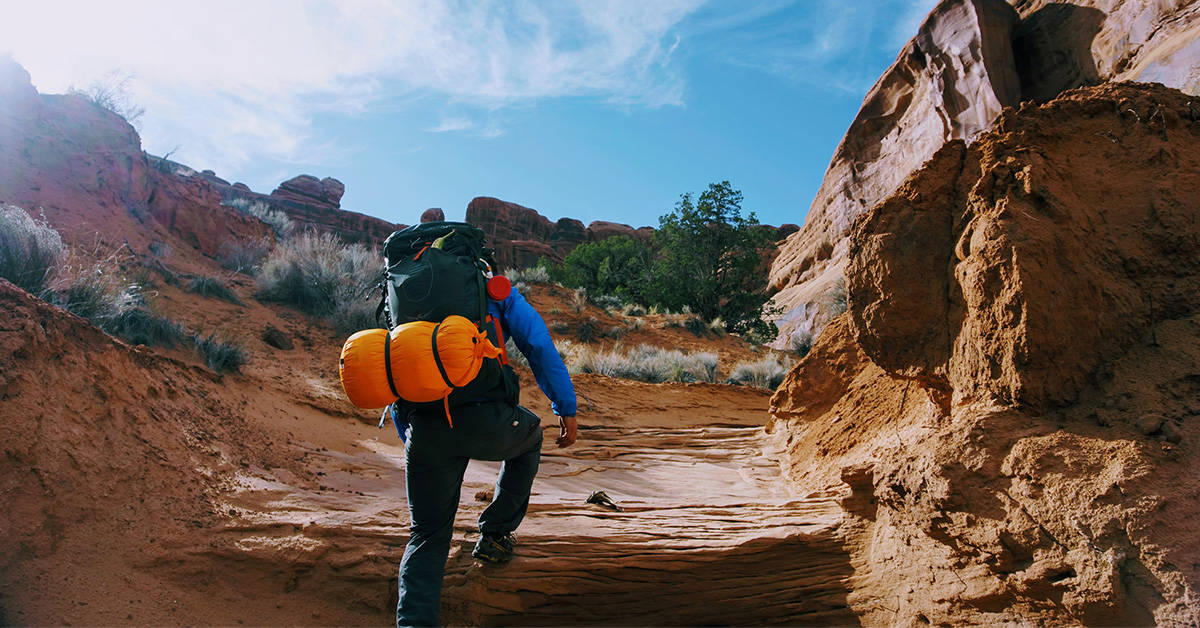
Many people suffer from hiker’s knee. Your knees go through more stress while hiking than on a typical walk. Three main culprits that add to the stress on your knees are the terrain, stride, and weight load.
Beginning hikers and experienced alike can suffer from knee pain when hiking. No matter your strength and experience, the knee joint is at risk of injury from hiking and if you are hiking with bad knees, the stress can worsen your condition.
Is Hiking Bad For Your Knees?
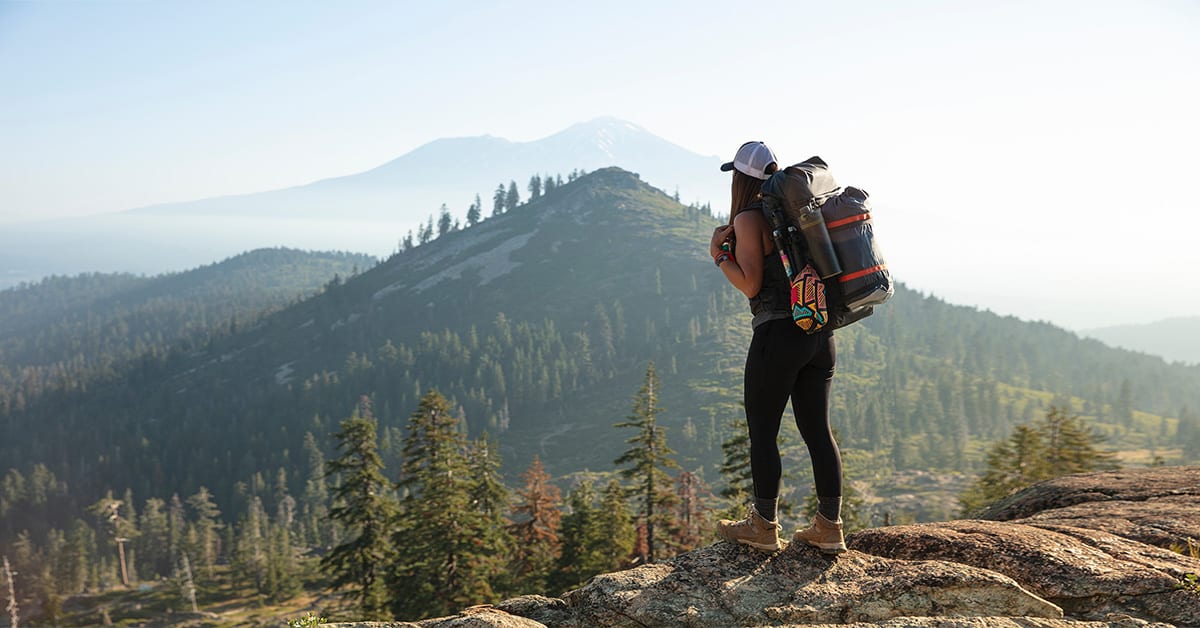
Many people wonder… Is hiking good for knees or is hiking bad for knees?
You can permanently damage your knees hiking. There are, however, easy ways to protect your knees and prevent injury to your knee joints while hiking.
Causes of knee pain while hiking can result from muscle strains, tendon sprains, tendinitis, tendonitis, cartilage tears, ACL injury, bursitis, arthritis, and more. Some of these knee injuries are temporary but others can become chronic or require surgery to correct.
Some hikers are more at risk of knee injury than others. It’s a genetic thing. Leg, knee, foot, hip, and muscle development can all play a factor.
Pay attention to knee pain while hiking. Pain, swelling, heat, redness, and loss of mobility are all indicators that you need to protect your knees so they’ll continue to provide you with a lifetime of hiking fun.
Is hiking good for your knees if done correctly? There are many physical benefits of hiking but hiking does cause stress to the knees.
If you think you may have an injury, don’t play around. Seek medical consultation immediately.
Is Hiking Downhill Bad for Your Knees?
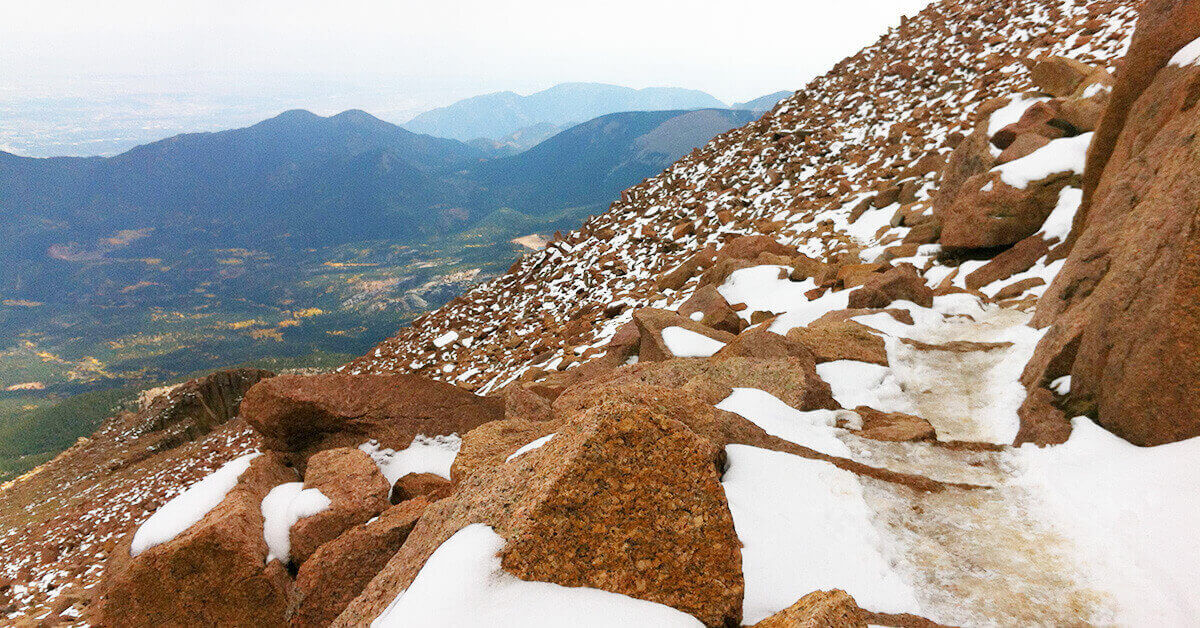
Knees hurt from hiking downhill due to the impairment in knee joint position. Hiking downhill exponentially increases the force applied to your knees leading to a greater chance of pain and injury.3
Most knee injuries occur from improperly hiking downhill but with a little focus on the right techniques, you can minimize the impact on your knees and minimize the possibility of sore knees after hiking downhill.
I once hiked 11 miles down Pikes Peak in Colorado. It was a painful experience that would have been better had I been prepared. I was missing a few things. (The picture above is my view as I headed down the icy trail.)
What was I missing for a long downhill hike? I had left my hiking boots behind in Nashville, TN and bought a new pair of hiking shoes at the REI store in Colorado Springs. A pair of crampons would have been nice with the icy trails up top. And I didn’t have my trekking poles with me either.
More on the proper techniques for hiking downhill below…
Is Hiking Uphill Bad for Knees?
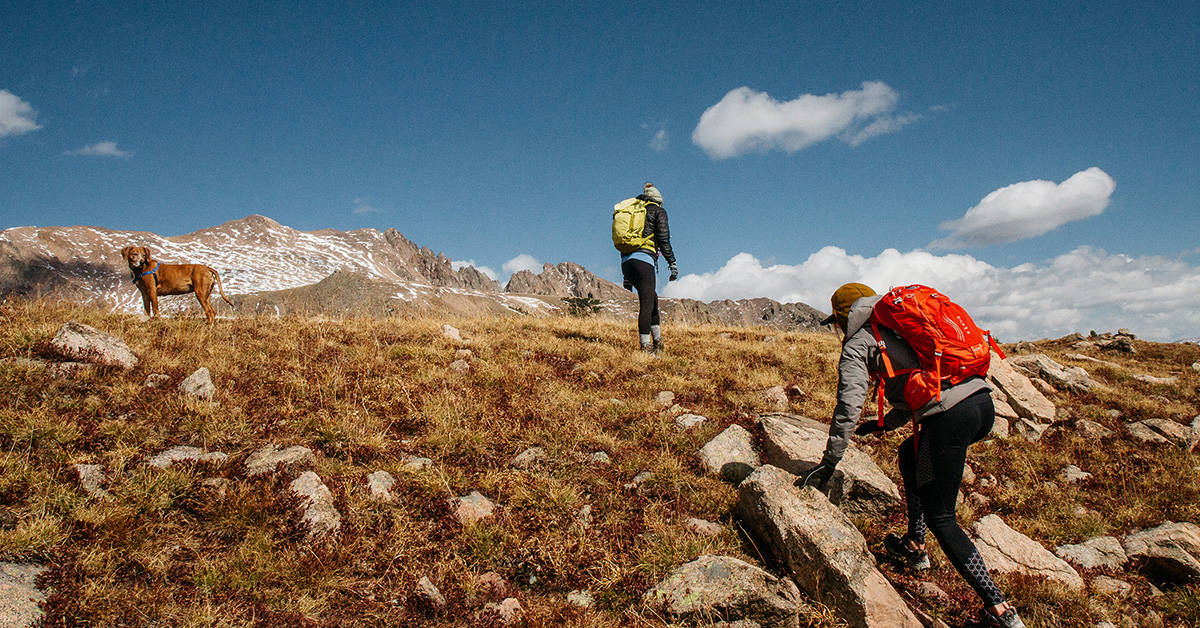
The weight-bearing impact on your knees is lower when hiking uphill making injury less likely though damage to the knee can still occur.
Many hikers have the tendency of letting their knees track forward when hiking uphill. To minimize the possibility of pain and damage to the cartilage in your knee, keep your knee and shin vertical to the ground while hiking uphill.
How To Prevent Knee Pain When Hiking
Your knees bear a great amount of weight while hiking making them vulnerable to injury. Luckily, there are simple ways to care for your knees when hiking.
1. Use the Right Gear
Having the right gear can help protect your knees while hiking.
Trekking Poles
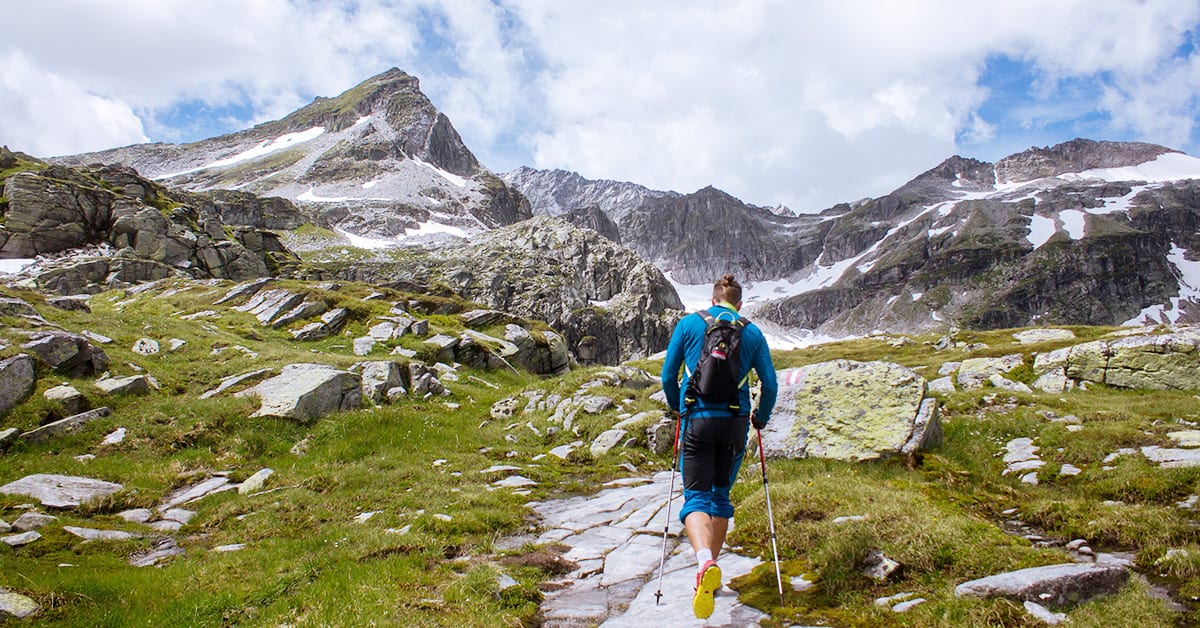
Trekking poles (hiking poles) can save a serious amount of stress on your knees, especially when hiking downhill.4
How do hiking poles help?
Trekking poles help redistribute weight to your arms and core providing improved stability and control on your hike while reducing the strain and impact placed on your knees and ankles.
A study in the Journal of Sports Sciences observed that the force placed on the knee joint was lowered by 12-25%.5
Trekking poles can even be purchased with shock absorption! Black Diamond Trail Pro Shock Trekking Poles have shock absorption. How cool is that?
Knee Braces
A knee brace can provide support and protection for your knee joint.6,7
If you don’t have specific knee problems and you’re looking for extra support to protect your knee from possible damage, consider a knee brace that leaves the kneecap exposed. An open patella brace, like the DonJoy Performance Stabilizing Knee Sleeve, provides support and allows proper movement and tracking without compressing the knee joint.
There are many knee braces on the market all designed for different needs. There are sleeves, wraps, straps, open & closed patella, and hinged. Your doctor or physical therapist can help you determine the best type for your situation.
Good Fitting Hiking Boots
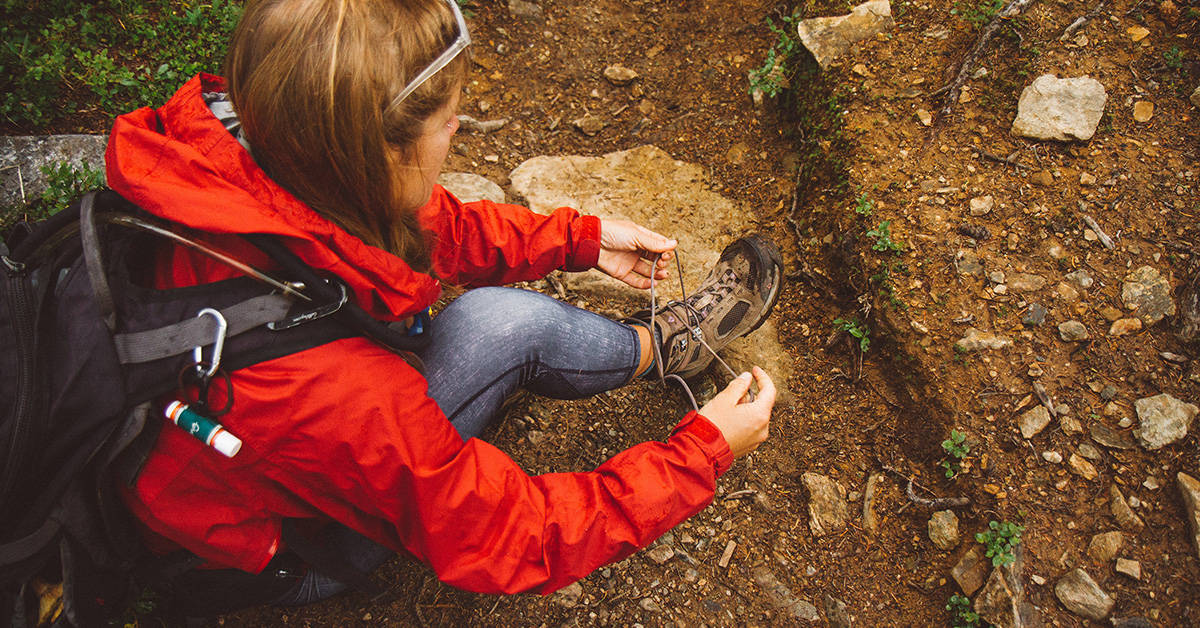
Hiking starts from the ground up. Improper footwear will take a toll on your ankles, knees, hips, and lower back.
The best hiking boots improve stability and traction while cushioning your steps to reduce strain and impact forces on your knee joint.
The best hiking boots:
- Are well-cushioned.
- Have thick soles with good traction.
- Have solid ankle support.
- Are made of sturdy yet flexible material.
Invest in the best hiking boot possible. If your feet hurt or become injured from improper footwear, your gait will be altered. This change in gait will cause strain on your knees.
If you’re not sure which hiking boots are right for you, I’d recommend visiting a reputable outfitter that can fit you in the proper shoe. Vasque is my favorite fit.
2. Hike Downhill Properly
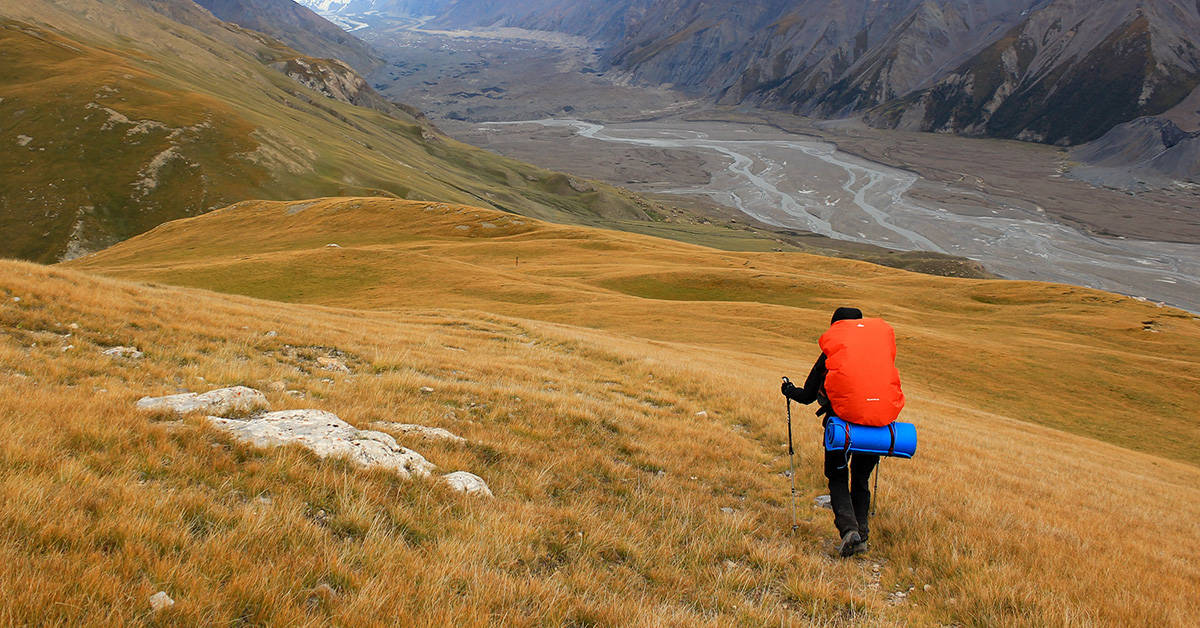
The techniques for properly hiking downhill involve softening the impact of your steps and improving stability.8
- Use a trekking pole for distributing weight and added stability.
- Avoid hiking boots that lack ankle support and tie your laces tight to secure your ankle. If your ankles are unstable, your change in gait will place added strain on your knee.
- Keep your knees loose and a spring to your step to soften the force applied to your knee joints. Stepping with your knees locked, stiff, or tight. Increases your chance of injury.
- Not too slow. Not too fast. The proper pace on a downward slope will decrease your chances of injury. Let gravity dictate your speed. Descending the trail too slowly adds pressure on the knee joint. Going too fast will increase your stride. Long strides also increase pressure on your knees.
- Hike in a zig-zag path. A zig-zag path will help control your descent and reduce the possibility of slipping in loose gravel or mud.
- Lean back slightly for greater stability.
- Side-step when you need added stability. Toes first offer less surface grip which increases your chance of slipping and lowers stability.
3. Hike Uphill Properly
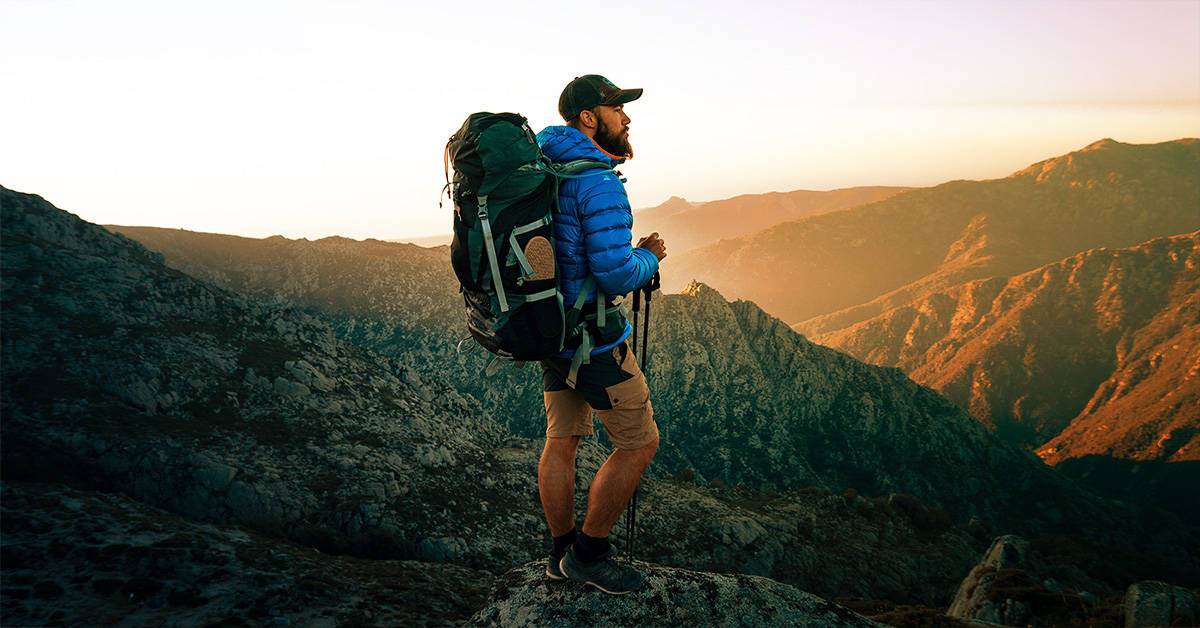
Keeping your shin and knee vertical to the ground while hiking uphill is best accomplished by:
- Stepping flat-footed instead of making steps on your toe.
- Taking shortened steps.
- Positioning your torso over your hips. Don’t lean forward too much though and don’t lean backward. Leaning backward will throw you off balance, thus increasing strain on your knees.
4. Stretch Before and After Your Hike
Stretching before your hike reduces your chances of injury by improving muscle flexibility.9
Stretch after your hike as well to loosen muscles that have contracted after the exertion. Tight muscles will continue to place a strain on your knee.
5. Reduce the Weight
Maintain a healthy body weight and keep the weight of your backpack down.10 Remove any unnecessary items and learn to evenly distribute weight in your pack.
6. Choose Your Trail Wisely
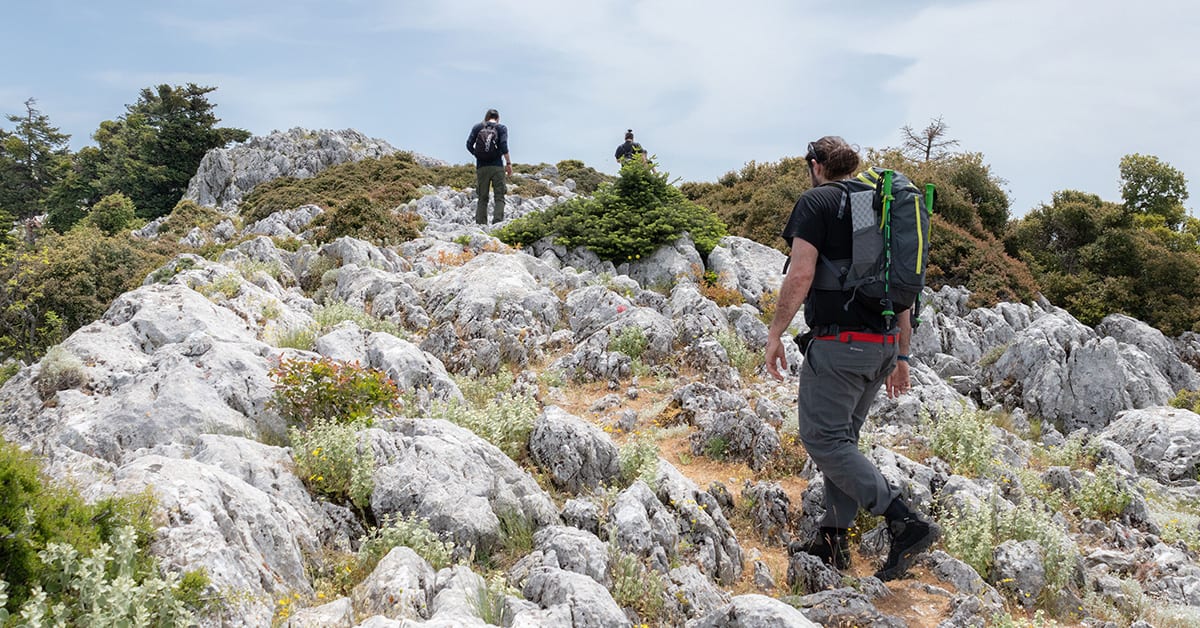
Choose trails that are within your skill level. Beginning hikers should start on level surfaces before hiking challenging terrain. Building up to more strenuous hikes over time allows your muscles to strengthen to support the knee joint.
Some trails are harder on your knees than others. The force placed on your knee is lower on dirt than on rocky trails… There’s a trail I like that is mostly limestone. I don’t hike there often due to the strain it places on my knees.
7. Visit a Podiatrist
Some hikers need orthotics or inserts in their hiking boots to improve foot problems along with knee and hip alignment.
I have orthopedic inserts that I got through my podiatrist that help me from the ground up.
8. Nutrition
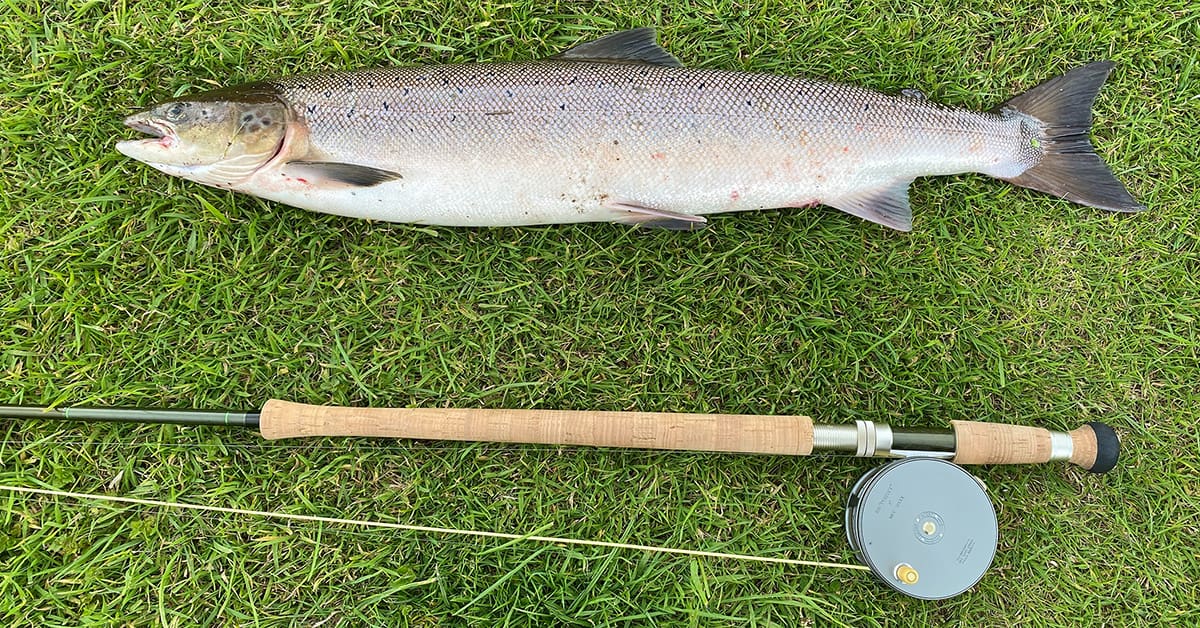
Your diet plays a big role in keeping your knees in shape.
Lubricating Foods
Omega-3
Omega-3 fatty acids help lubricate your joints and reduce inflammation.11,12 Salmon, mackerel, walnuts, flaxseed, chia seeds, hemp seed, olive oil, and eggs are just a few of the foods rich in Omega-3s.
Not sure you’re getting enough Omega-3? You can take an Omega-3 fish oil supplement. I prefer Thorne Research Omega Plus. It’s not at all fishy if you happen to burp. Some of the others are just plain nasty!
Glucosamine & Chondroitin
Another supplement to consider is a glucosamine and chondroitin combination.13,14 Studies show the combination to be more beneficial than glucosamine alone.
Glucosamine helps with joint function by lubricating and protecting joints along with the formation of cartilage.
Anti-Inflammatory Diet
The inflammation you experience in your knees while hiking may be partly due to the foods you eat. One of the best ways to reduce inflammation is to follow an anti-inflammatory diet.15
Inflammation is a natural way the body protects itself from infection, illness, or injury. With regard to food, some cause inflammation and some reduce inflammation.
Foods That Cause Inflammation
- Sugar and high-fructose corn syrup
- Artificial trans fats
- Vegetable and seed oils
- Refined carbohydrates
- Alcohol
- Processed meat
- Fried food
These are just a few of the foods that cause inflammation and quite possibly contribute to knee inflammation on your hike.
These foods that cause inflammation are generally considered unhealthy and contribute to weight gain which is itself a risk factor for inflammation.
Foods That Reduce Inflammation
A diet of anti-inflammatory foods could help to reduce inflammation in your knee while hiking.
- Fruits like blueberries, strawberries, cherries, blackberries, raspberries, and avocados.
- Vegetables such as tomatoes, carrots, eggplant, onions, peppers, spinach, kale, broccoli, and beans.
- Fatty fish like salmon, tuna, and sardines.
- Nuts like almonds, walnuts, and pistachios.
- Spices like turmeric and garlic
- Green Tea
- Mushrooms
- Extra virgin olive oil
- Dark chocolate
5 Ways to Relieve Sore Knees After Hiking
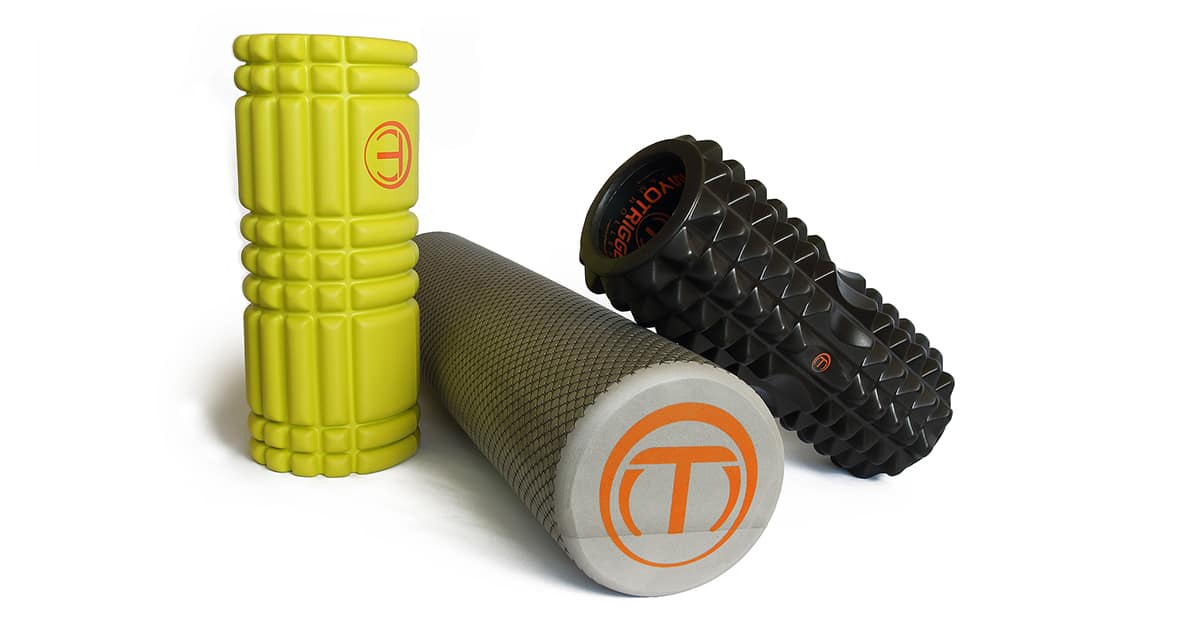
You’ve taken the proper precautions, but you still have knee pain after your hike. Great news! There are things you can do to minimize the pain and speed up healing and recovery.
- NSAIDs can reduce pain and inflammation.
- RICE (rest, ice, compression, and elevation) decreases pain and swelling and promotes healing.
- Stretching after your hike will help with tight and sore muscles. Tightness after your hike stresses the knee joint. Maintaining flexibility in the days after your hike will help.
- Massage your feet, leg, and hip muscles. Muscle tightness can place stress on the knee joint.16
- Give your knee a rest after hiking. Consider a 3-5 day break before getting onto your fitness routine. The longer or more strenuous the hike the longer the break.
Need help with massaging those muscles? The following are my favorite massage tools from TriggerPoint. (Amazon always has great pricing on TriggerPoint products.)
If these steps don’t help your sore knees after hiking, speak with your doctor or visit a physical therapist. My physical therapists have created personalized strategies that have done wonders for me over the years. I’m greatly indebted to them for their help.
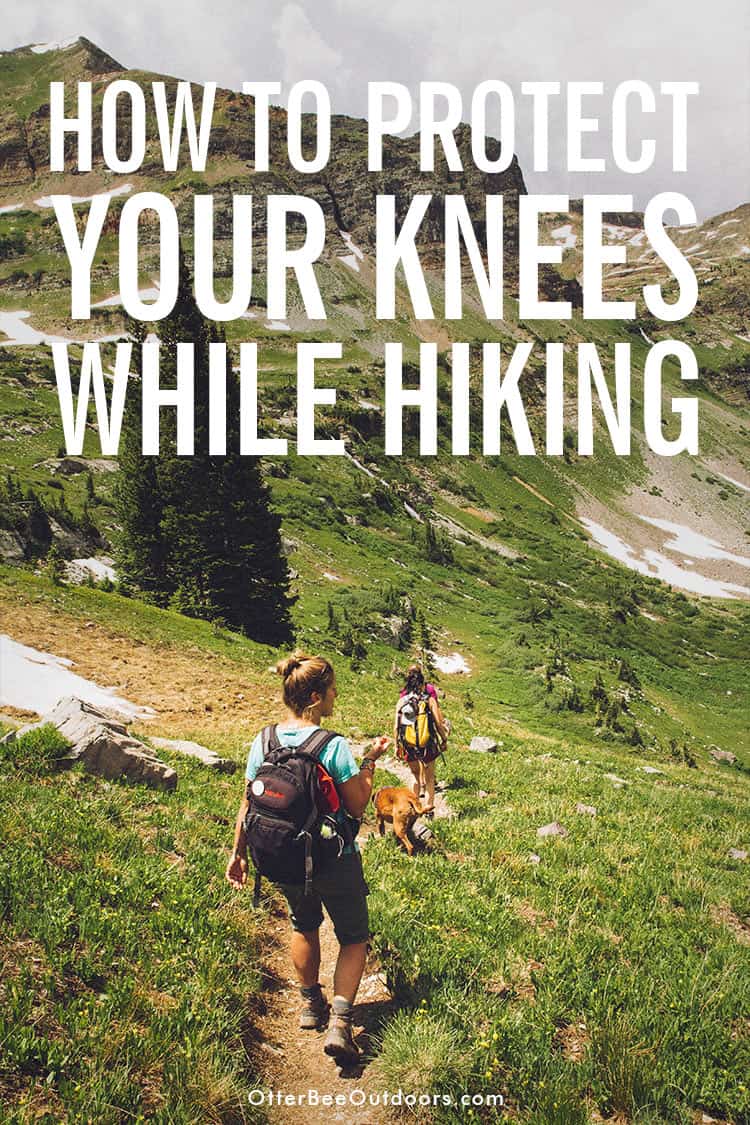
References
- Barbara Freidt, Eddie Hill, Edwin Gómez, and Marni Goldenberg. A Benefits-Based Study of Appalachian Trail Users: Validation and Application of the Benefits of Hiking Scale. Physical Health Education Nexus (PHENex). Volume 2, Issue 1, January 1, 2010, pages 1-22.
- Rob Jordan. Stanford Researchers Find Mental Health Prescription: Nature. Stanford News. June 30, 2015.
- G. Bottoni, D. Heinrich, P. Kofler, M. Hasler, and W. Nachbauer. The Effect of Uphill and Downhill Walking on Joint-Position Sense: A Study on Healthy Knees. Journal of Sport Rehabilitation. August 1, 1997. 2015 Nov;24(4):349-52.
- M. Bohne and J. Abendroth-Smith. Effects of Hiking Downhill Using Trekking Poles While Carrying External Loads. Medicine & Science in Sports & Exercise. 2007 January, 39(1):177-83.
- H. Schwameder, R. Roithner, E. Müller, W. Niessen, and C. Raschner. Knee Joint Forces During Downhill Walking with Hiking Poles. Journal of Sports Sciences. 1999 Dec;17(12):969-78.
- A. Derouin and J.R. Potvin. The Effect of Functional Knee Braces on Muscular Contributions to Joint Rotational Stiffness in Anterior Cruciate Ligament-Deficient and -Reconstructed Patients. Journal of Applied Biomechanics. 2019 Oct 1;35(5):344-352.
- A. Budarick, B. MacKeil, S. Fitzgerald, and C. Cowper-Smith. Design and Mechanical Evaluation of a Novel Multi-Compartment Unloader Knee Brace. Journal of Biomechanical Engineering. 2019 September 1.
- Bert H. Jacobson, Bryan Caldwell, and Frank A. Kulling. Comparison of Hiking Stick Use on Lateral Stability While Balancing with and without a Load. Perceptual and Motor Skills. August 1, 1997. Volume: 85 issue: 1, page(s): 347-350.
- M. Iwata, A. Yamamoto, S. Matsuo, G. Hatano, M. Miyazaki, T. Fukaya, M. Fujiwara, Y. Asai, and S. Suzuki. Dynamic Stretching Has Sustained Effects on Range of Motion and Passive Stiffness of the Hamstring Muscles. Journal of Sports Science and Medicine. 2019 February 11;18(1):13-20.
- P. DeVita, P. Rider, and T. Hortobágyi. Reductions in Knee Joint Forces with Weight Loss are Attenuated by Gait Adaptations in Class III Obesity. Gait & Posture Journal. 2016 March;45:25-30.
- Reviewed by UPMC Orthopaedic Care. 4 Fish Oil Facts to Help Ease Joint Pain. UPMC HealthBeat. November 2, 2014.
- P. Peanpadungrat. Efficacy and Safety of Fish Oil in Treatment of Knee Osteoarthritis. Journal of the Medical Association of Thailand. 2015 April;98 Suppl 3:S110-4.
- Xiaoyue Zhu, Lingli Sang, Dandong Wu, Jiesheng Rong, and Liying Jiang. Effectiveness and Safety of Glucosamine and Chondroitin for the Treatment of Osteoarthritis: a Meta-Analysis of Randomized Controlled Trials. Journal of Orthopaedic Surgery and Research. Article number: 170 (2018).
- Healthbeat. Do Glucosamine and Chondroitin Really Help Arthritis Pain? Harvard Health Publishing: Harvard Medical School.
- Harvard Women’s Health Watch. Foods that Fight Inflammation. Harvard Health Publishing: Harvard Medical School.
- R.A. Capobianco, M.M. Mazzo, and R.M. Enoka. Self-Massage Prior to Stretching Improves Flexibility in Young and Middle-Aged Adults. Journal of Sports Sciences. 2019 July;37(13):1543-1550.
OtterBee Outdoors is for entertainment purposes only and should not be considered medical advice, diagnosis, or treatment recommendations. Statements regarding dietary supplements and other statements on the site have not been evaluated by the FDA and are not intended to diagnose, treat, cure, or prevent any disease or health condition. Please consult a physician to determine your best plan for treatment.



